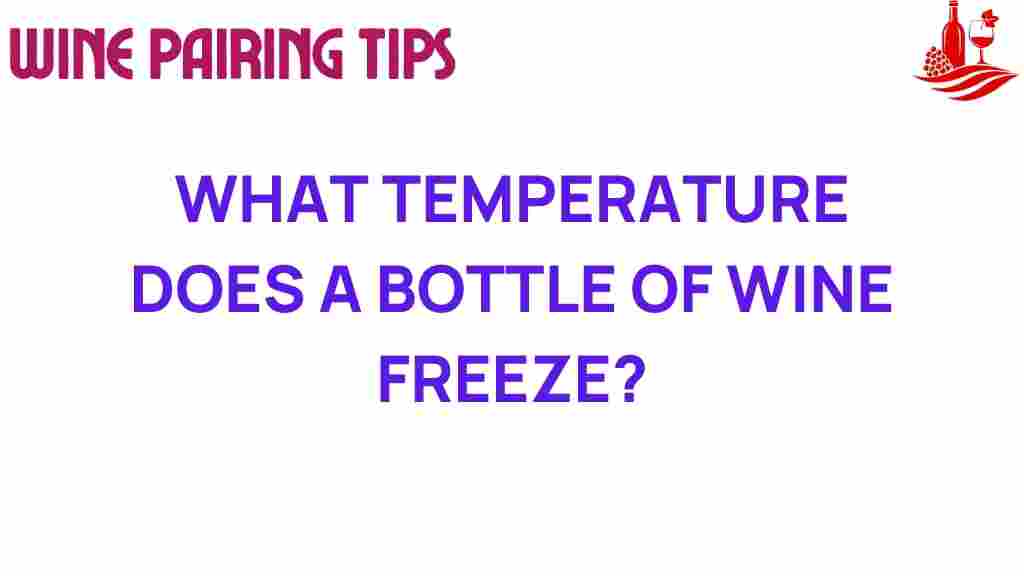The Chilling Truth: What Temperature Does Wine Freeze?
When it comes to enjoying wine, understanding the wine freezing point and proper wine storage is crucial for preserving its quality and flavor. Many wine enthusiasts may wonder, “What temperature does wine freeze?” This article will explore the freezing point of wine, the optimal wine temperature for serving, and essential wine tips to ensure your collection stays in perfect condition. Let’s dive into the chilling truth!
Understanding Wine Freezing Point
The wine freezing point is a critical factor to consider for anyone who wants to enjoy their wine at its best. Generally, the freezing point of wine is lower than that of water, usually around 15°F to 20°F (-9°C to -6°C), depending on the alcohol content and sugar levels in the wine. Here are a few important points to remember:
- Alcohol Content: Higher alcohol content lowers the freezing point. Most wines have an alcohol content between 8% and 15%, affecting their freezing temperatures.
- Sugar Levels: Sweet wines have higher sugar levels, which also result in a lower freezing point.
- Type of Wine: Different types of wine (red, white, rosé, sparkling) may have varying freezing points based on their composition.
Factors Affecting Wine Freezing Point
Several factors contribute to the specific wine freezing point of a particular bottle:
- Alcohol by Volume (ABV): Wines with higher ABV generally freeze at lower temperatures.
- Residual Sugar: Sweeter wines have lower freezing points due to the presence of sugar.
- Wine Composition: The acidity and other components can also influence the freezing point.
Optimal Wine Temperature for Storage and Serving
To preserve the integrity of your wine, it’s essential to store it at the right temperature. Here’s a comprehensive temperature guide for wine storage and serving:
Wine Storage Temperatures
Wine should be stored in a consistent environment, ideally between 45°F and 65°F (7°C to 18°C). Here are some specific recommendations:
- Red Wine: Best stored at 55°F to 65°F (13°C to 18°C).
- White Wine: Ideal storage temperature is 45°F to 50°F (7°C to 10°C).
- Sparkling Wine: Should be stored at a cooler temperature, around 40°F to 50°F (4°C to 10°C).
Wine Serving Temperatures
The temperature at which you serve wine can significantly impact its flavor and aroma. Here’s a quick guide to the ideal serving temperatures:
- Full-Bodied Red Wine: Serve at 60°F to 65°F (16°C to 18°C).
- Light-Bodied Red Wine: Serve at 55°F to 60°F (13°C to 16°C).
- Full-Bodied White Wine: Serve at 50°F to 55°F (10°C to 13°C).
- Light-Bodied White Wine: Serve at 45°F to 50°F (7°C to 10°C).
- Sparkling Wine: Serve chilled at 40°F to 45°F (4°C to 7°C).
Wine Preservation Tips
To ensure that your wine maintains its quality, consider these wine tips for preservation:
- Use a Wine Fridge: A dedicated wine fridge can help maintain optimal temperatures.
- Avoid Temperature Fluctuations: Consistent temperature is crucial; avoid storing wine in places where temperatures vary.
- Keep Away from Light: UV light can degrade wine, so store in a dark place or use UV-protective bottles.
- Store Bottles Horizontally: This keeps the cork moist and prevents oxidation.
Step-by-Step Process: How to Properly Store Wine
Storing wine correctly requires attention to detail. Follow these steps for optimal wine storage:
Step 1: Choose the Right Location
Find a cool, dark place with consistent temperature. A wine cellar, wine fridge, or a dedicated shelf in your home can work well.
Step 2: Control Humidity
A humidity level of 50% to 70% is ideal for storing wine. Too much humidity can damage labels, while too little can dry out corks.
Step 3: Maintain Temperature Stability
Avoid storing wine near heat sources, such as ovens or radiators. The ideal storage temperature is around 55°F (13°C).
Step 4: Organize Your Collection
Keep similar types of wines together for easy access. Label your bottles if necessary for quick identification.
Step 5: Monitor Your Wine
Check your wine regularly for any signs of spoilage or temperature fluctuations. Investing in a wine thermometer can help.
Troubleshooting Common Wine Storage Issues
Even with the best intentions, issues can arise in wine storage. Here are some common problems and solutions:
Problem 1: Wine Freezing
If you accidentally leave wine in a freezing environment, it may freeze. Here’s what to do:
- Take it out immediately and allow it to thaw at room temperature.
- Check for any leaks in the bottle; a frozen cork can push out and spoil the wine.
Problem 2: Cork Damage
If the cork dries out due to low humidity, your wine might oxidize. To prevent this:
- Maintain a humidity level between 50% and 70%.
- Consider using synthetic corks or screw caps for long-term storage.
Problem 3: Off Flavors
Sometimes, wine can develop off flavors due to improper storage. To avoid this:
- Keep wine away from strong odors, as wine can absorb smells.
- Store bottles upright if you’re using synthetic corks.
Conclusion
Understanding the wine freezing point and how to store and serve wine at the correct temperatures is essential for any wine lover. By following the tips and guidelines outlined in this article, you can ensure that your wine remains in excellent condition, ready to be enjoyed. Remember that proper wine storage and an awareness of wine temperature can make all the difference in your wine experience. For further reading on wine preservation techniques and tips, check out this comprehensive guide on wine storage. Cheers to enjoying every sip!
This article is in the category Tips and created by Wine Pairing Tips Team
